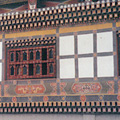As with all the zorig chusum, shingzo is a devotional act, which links the craftspeople to their personal deities. For centuries houses, palaces, dzongs, temples, bridges and utilitarian items for the home and the field have been and continue to be made of a combination of stone, rammed earth, bamboo and local timber or wood. Timber is used lavishly in all structures for windows, doors, stairs, balconies, columns, beams and other structural elements and for elaborate decorative cornices. It is this lavish use of timber, which gives Bhutanese architecture its beauty, elegance and unique character at the same time making these structures highly vulnerable to fire and degeneration.
The techniques used by the craftspeople have remained relatively unchanged and even today the basic constructional elements for the building of a house are made by hand with the help of a few tools only. Buildings are not constructed according to a set floor plan but at the same time follow measurements dictated by the sacred scriptures. The carpenters plan and prepare the necessary building elements based on an understanding of the sacred texts and supervise the work when the construction begins. Massive Dzongs, Lhakhangs and Gompas, palaces, houses – some of which are built on mountain tops, sheer cliff faces, at strategic places -are erected without either a floor plan and most remarkably without iron, not even nails.

Common to every structure are the intricate decorations, woodcarvings and brightly coloured patterns and murals on wall panels. Carvings of Lord Buddha and various other deities adorn the walls and altars of temples and shrines. The common motifs on more secular buildings are the druk (dragon), Tashi – Tagye and various legendary animals (refer article on symbols). The upper stories of a building boast remarkable woodwork with paintings seen frequently on the frames of the three lobed windows and on the ends of beams. Elaborately painted timber cornices are usually placed around the upper edges of the structure, just below the roof and above doors and windows. Windows and doors are also normally painted giving the houses a very festive appearance. Floral, animal and religious motifs are mainly used as themes for the colourful paintings.

Timber is used for flooring, doors, windows, beams and ceilings in houses. Doors and windows are generally carved with traditional motifs. Very narrow timber window are found on the lower floors and larger elaborately painted timber three lobed windows on the top floor. Roofs are of made of wooden shingles kept in place with small stones. Large open breezy spaces under the high, shingled roofs, create the unique ‘flying roof’ characteristic, which is peculiar to indigenous Bhutanese houses. A single log of wood with ledges cut on one side serves as a staircase. Almost every house has a wooden altar with statues of the Buddha and the great gurus.



